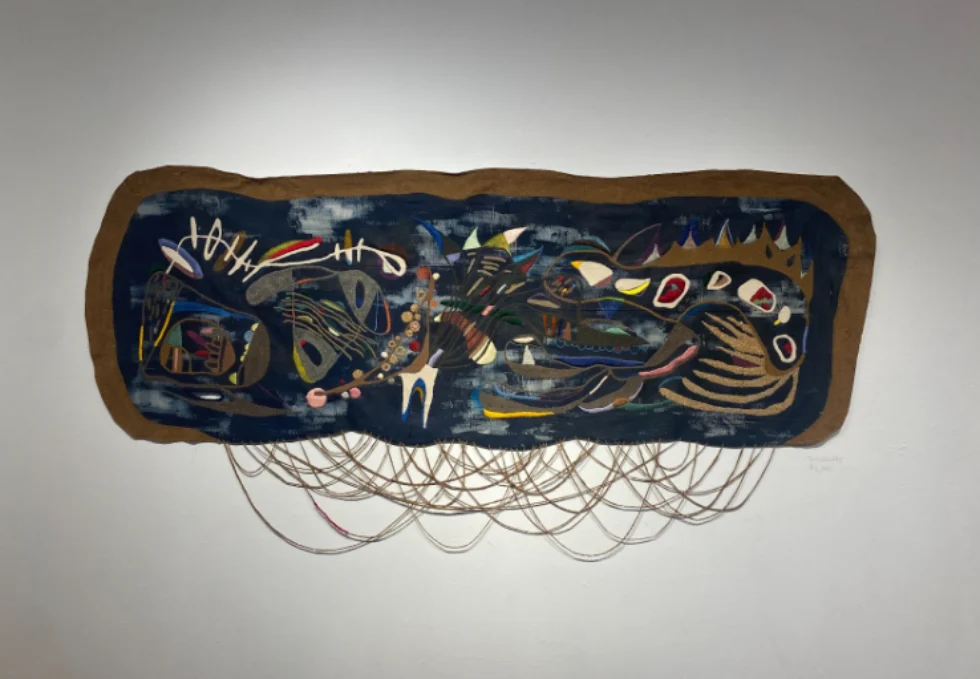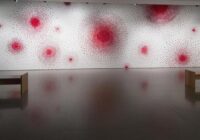I attended Art Lives Here: Collecting, an art fair at Westbeth Gallery in Manhattan late last month. I did not stay long, though I was somewhat impressed by a few pieces in the cluttered show.
On display in the four Westbeth gallery rooms were dozens of works by 52 artists on canvas and paper, some ceramic and metal sculptures and various multimedia pieces made from an array of materials like felt, newspaper, plastic and metal. Some 3D works were mounted on the wall or the columns in the middle of the gallery space.
Most of the work was mediocre, something one might see in the living room of someone who wrongly thinks they have good taste — or a doctor’s office that needed to replace its faded Monet prints.
Attempted formalism is not an excuse for lazy art
The legacy of modernism was clear from the work on display. Nearly none of the pieces told stories. Instead, most of them were formalistic. That is, they emphasized the formal qualities of the work: its shapes, colors, textures, size, how those elements interact with one another and the sensations that their appearance produces in the viewer. At least, that is the idea.
The large, blocky and colorful shapes in many of the pieces reminded me of a McDonald’s PlayPlace or the toys and decorations in a kindergarten classroom, especially the human-sized white minimalist sculpture made of either wood or plastic that combined the outline of a house, a white picket fence and a tree.
Indeed, the show was characterized by a playful, childlike quality — like an adult version of arts and crafts. Much of the work lacked a sense of seriousness. However, this was a strength for some pieces, like Capucine Bourcart’s, that looked like fabric versions of Arshille Gorky’s paintings. These pieces were large enough to grab my attention and pleasant to look at because of the contrast between colors, saturation and shape size.
Still, much of the work was underwhelming and amateurish. Many pieces relied too heavily on the assumption that warm pastel colors, saturation and formal simplicity would make them inherently interesting. Light red and pink colors dominated a wall of small works on paper and canvas, which was boring due to a lack of contrast.
The overcrowded nature of the show did not help either. Many of the 2D pieces were presented salon-style. Drawings and paintings with similar color palettes and saturation levels were stacked on top of one another and placed too close together horizontally. This presentation did not give the pieces space to breathe, and works that were too similar were placed too close together.
The fair was generally apolitical except for two collages of Biden’s infamous “DEI hires,” Vice President Kamala Harris and Supreme Court Justice Ketanji Brown Jackson. The collages beamed with the same dull “art a mom would make on a Sunday” energy as much of the other work at the fair.
Groux, Rodríguez and Fitzgerald were flowers among the weeds
I was more impressed by the 3D works than the smaller paintings and drawings. Laurence Elle Groux’s ceramic sculptures were genuinely interesting. Many small organic shapes came together to form visually complex sculptures about the size of a human head. Three were on pedestals justifiably placed in the center of the gallery that featured the most 3D work.
I also enjoyed Jorge Luis Rodríguez’s sculptures. They hung in the same room as the ceramics. My favorite one was small but stimulating to the eye because of the combination of negative space, contrasting saturated colors, shadows and dark, flat triangles and squares.
The most impressive piece, correctly placed in the front, was Karen Fitzgerald’s polyptych that comprised four tondos (circular paintings). The largest had a diameter of about four or five feet. Before contemplation, the paintings appeared like colorful clouds. Further examination revealed something like a bird’s eye view of opened clamshells with a shiny pearl in each.
Matters of taste in New York galleries have been democratized oddly. Graduates of New York’s finest art schools — those with a finer aesthetic sensibility — have difficulty entering the art market. The low-level galleries that once gave them a clear career path now dwindle. Yet, uninteresting amateur art seems to get into an increasing number of galleries instead of being kept out by curators.
Quality work will always filter through and will always stand out to gallery attendees. Perhaps this is a strength of the system. If a painting is splendid, dynamic or sublime, even a person who lacks the refined taste provided by art education will find that mediocrity starkly contrasts with quality when the two are placed side by side. Unfortunately, almost none of the work at the fair stood out strongly enough to create such a distinction.
The views expressed in this article are the author’s own and do not necessarily reflect Fair Observer’s editorial policy.
Support Fair Observer
We rely on your support for our independence, diversity and quality.
For more than 10 years, Fair Observer has been free, fair and independent. No billionaire owns us, no advertisers control us. We are a reader-supported nonprofit. Unlike many other publications, we keep our content free for readers regardless of where they live or whether they can afford to pay. We have no paywalls and no ads.
In the post-truth era of fake news, echo chambers and filter bubbles, we publish a plurality of perspectives from around the world. Anyone can publish with us, but everyone goes through a rigorous editorial process. So, you get fact-checked, well-reasoned content instead of noise.
We publish 2,500+ voices from 90+ countries. We also conduct education and training programs
on subjects ranging from digital media and journalism to writing and critical thinking. This
doesn’t come cheap. Servers, editors, trainers and web developers cost
money.
Please consider supporting us on a regular basis as a recurring donor or a
sustaining member.
Will you support FO’s journalism?
We rely on your support for our independence, diversity and quality.








Comment